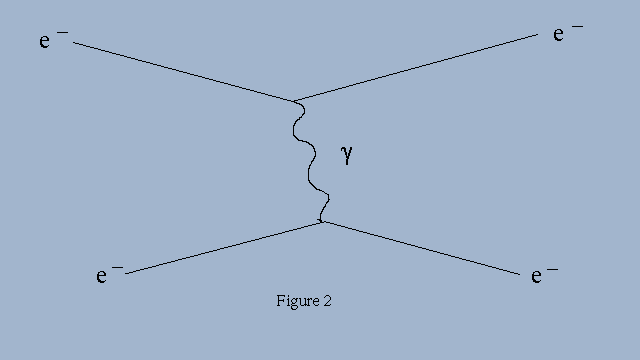The technical stuff
A an example of Feynman Diagrams, by Len Bugel.
A modern Physics View of Force
The Standard Model of Elementary Particles and Forces (Standard Model for short), which describes the building blocks of the universe and the interactions among these building blocks, recognizes just two fundamental types of particles and four forces. The particles of matter can be divided into quarks and leptons, and the forces are the strong force. The weak force, the electromagnetic force, and gravity. The theories that describe the first three of these interactions are Quantum Field Theories (gravity, for the time being, is the odd man out), and all quantum field theories treat forces in the same interesting way: forces between particles result from the exchanging of Gauge Bosons, particles which are said to mediate the forces. It is this interesting feature of modern physics I would like to discuss, in terms understandable to high school physics students, after they have learned about conservation of momentum. The space shuttle presents an ideal stage on which to illustrate the main idea here, and hopefully all students have seen some video images of astronauts at work in the shuttle's cargo bay. Specifically, the space shuttle, being in free fall through space, is the ideal place to see Newton's first law at work. Objects in motion really do tend to remain in motion at constant velocity when we remove the annoying interference of gravity and air resistance! Here then is the opportunity to demonstrate a force as the exchange of a particle. Two astronauts, Amy and Bart, working in the cargo bay, have pushed off from one wall, and are drifting at constant velocity down the bay. (See Figure 1) Bart notices that Amy has a nice big wrench, and asks to borrow it. At point 1 in the diagram, A gives the wrench a toss. Since the wrench now has some transverse momentum, and the momentum of the system A + W must be conserved, A's velocity vector must change -- she must acquire some transverse motion in the direction opposite the wrench. At some later time, point 2 in the diagram, B catches the wrench, and now the conservation of momentum for B + W requires B's velocity vector to change. (I've drawn the path of the wrench with a wiggly line because Amy gave it a bit of spin as she tossed it.) Now if you imagine all this taking place in the dark, with A and B each wearing a light, an observer would not see the wrench at all, but instead would see two particles repel each other! The little diagram inside the cargo bay tells us exactly what went on here, and since it does such a fine job of explaining the interaction between two humans, I am going to refer to it as the fine man diagram (pun definitely intended).
From this point, it is easy to replace A and B in the fine man diagram with two particles of like charge, say two electrons, replace the wrench with a photon, and we have the Feynman diagram for a typical electromagnetic interaction (Figure 2). As before, the exchanged particle is shown as a wiggly line. (Richard Feynman, inventor of this handy little diagramming technique, received the Nobel Prize in physics for his work on quantum electrodynamics, the currently accepted theory of electromagnetism.)
Of course the repulsion of two like-charged particles is not the only sort of force in nature - a good thing for us! - but in fact all forces can be thought of in this same way. An immediate question, and one your students will bring up, is how do you explain an attraction, such as that between an electron and a proton. In our analogy we can replace the tossed wrench with an extended pole of some sort, so each astronaut can tug on it. (Not only will the pole be under tension, but the analogy is being stretched pretty taut as well!) The best description of what happens in quantum field theory is that the exchanged particle carries negative momentum - not an easy thing to visualize. The exchanged gauge bosons are in fact all virtual particles, can never be directly observed, and "borrow" momentum from the quantum field, subject only to the limitations of the Heisenberg Uncertainty relation. (Real, observable versions of these bosons can also exist, but they no longer mediate forces. The real photon becomes the quantum of light, for instance.)
Mr. Bugel goes on in further detail, but I have chosen not to include the rest of the essay as the above accomplishes a fair understanding of how the Feynman diagrams work in a very clear manner. So I guess it wasn't quite so technical after all. If you would like to read the full essay I have included a link at the top of the page.

